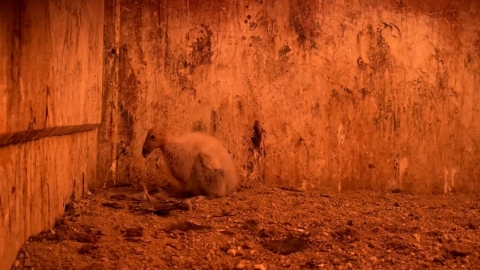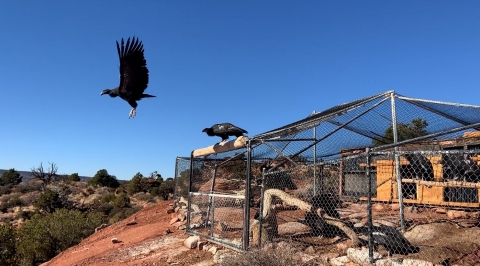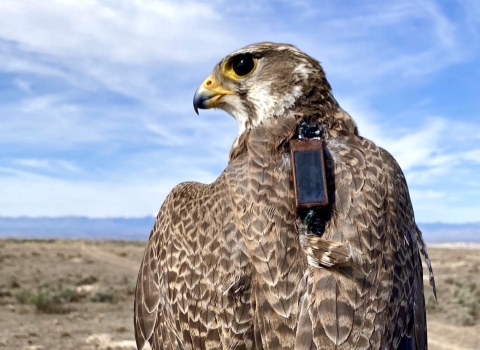For a certain kind of person, it’s a dream job.
You’ve got to be the kind of person who’s okay with hatchings and fledglings: the hatching of dreams and birds, and the eventual fledging of both.
You’ve got to be the kind of person who’s got some pluck: not of feathers, but of the stick-to-it-iveness that comes with durable conservation goals.
Finally, you’ve got to be the kind of person who’s okay with long goodbyes. Like two-year, 10-foot wingspan long goodbyes.
Leah Esquivel is that kind of person.
“I’ve been working here for seven years and I love it,” Esquivel, propagation manager at The Peregrine Fund in Boise, Idaho, said. “I worked at some zoos and a few other places, but when I saw the opening here I thought it was amazing. Luckily, I got the job.”
The Peregrine Fund is an organization dedicated to conserving birds of prey worldwide and works closely with the U.S. Fish and Wildlife Service towards achieving that goal. Founded in 1970 at Cornell University to save peregrine falcons from extinction, the organization has bred and released about 5,000 falcons and other birds of prey and has worked with more than 100 raptor species in 40 countries. The Peregrine Fund works to protect the birds’ habitat and educate students about the importance of conservation.
But Esquivel’s job may be one of the best of all: she helps breed condors.
“It’s really a great team here where we’re willing to roll our sleeves up and get the work done,” Esquivel said. “And then, of course, I just love working with the condors.”
WATCH VIDEO "Miracle" Condor 1221—affectionately nicknamed "Milagra"—plays with a massive shed feather from one of her adoptive parents at the World Center for Birds of Prey in Boise, ID. She was rescued while still in the egg after her mother was lost to Highly Pathogenic Avian Influenza and hatched at Liberty Wildlife in Phoenix before being transferred to The Peregrine Fund's propagation facility.
After getting a bachelor’s degree in zoology at California State University, Long Beach, Esquivel landed an internship and subsequently a seasonal job with the U.S. Fish and Wildlife Service in Ventura, California, working with wild birds. While in Ventura, Esquivel fell in love with condors.
It’s hard not to fall in love with condors. As one of the largest land birds in North America, a condor can weigh 25 pounds and have a 10-foot wingspan. They have black feathers, iconic bald heads, and a stupefying ability to fly 250 miles a day.
“They’re really cool birds,” Esquivel said. “The captive propagation program, first for falcons and now also for the condors, has been a core part of The Peregrine Fund from the beginning, and it’s really expanded and grown into this huge thing. I feel honored to be a part of it.”
The California condor was originally listed as endangered by the federal government in 1967 under the Endangered Species Preservation Act of 1966, the predecessor to the Endangered Species Act. The ESA provides critical protection for the condor, as well as hundreds of other imperiled fish, wildlife, and plants, and the habitats upon which they depend. However, despite the protection of the ESA, by 1982 only 22 condors survived in the wild.
To save the species, the Service began working with partners to capture the remaining wild condors and initiate captive breeding. After years of hard work, in 2004 a bred chick successfully hatched in the wild; by 2008, more condors were flying free in the wild than when the captive breeding program began. Today, condor recovery is still a Service-led international multi-entity effort and includes mitigating threats to the species in the wild, captive breeding, and release and monitoring at field sites.
With support from the Service, in 1993 The Peregrine Fund began breeding condors at its World Center for Birds of Prey in Boise, Idaho. The Peregrine Fund also coordinates with Los Angeles Zoo and Botanical Gardens, San Diego Zoo Safari Park and Oregon Zoo to set breeding goals and designate release locations. In its 52 years of existence, the World Center for Birds of Prey has raised more than 300 condors.
WATCH VIDEO: Young captive-bred California Condors preening in the socialization pen at the propagation facility at the World Center for Birds of Prey in Boise, Idaho.
“What’s remarkable is that they’re really raising the future of the California condor population,” said Matt Stuber, the Service’s raptor and energy lead. “Right now, condors don’t have the ability to sustain themselves in the wild. When you think about how close these birds got to extinction, and what organizations like The Peregrine Fund are doing to help them recover, you can really feel the scope and gravity of their work.”
But raising condors takes work, and people like Esquivel are the ones who get it done. The Center currently holds 57 condors, seven aplomado falcons and 19 taita falcons. That’s a lot of raptors.
“It’s a lot of observing and making sure everyone is doing well, especially when they have chicks or eggs they’re caring for,” Esquivel said. “During breeding season we artificially incubate all our eggs to make sure they’re safe. That way when they get close to hatching we’re able to jump in and help if they need it.”
Esquivel described a command room in the propagation center filled with video monitors where specialists can watch the birds remotely 24 hours a day. Because the condors will eventually be released into the wild, Esquivel and her colleagues are fastidious about staying out of sight so the birds don’t become habituated to humans. Specialists feed them through food chutes and watch them either on video or through one-way glass. They also try to keep the propagation facility as sterile as possible to protect the birds from avian influenza and other diseases.
“They’re really careful,” Stuber said. “I’m sure these condors have no idea that they’re being raised by humans.”
A condor is a carrion-eating bird, meaning that it feeds on animals that are already dead. Their diets at the propagation center consist of some smaller pieces of food such as beef, horsemeat, rats, and rabbits, and then a few times a month the birds receive large carcasses. Esquivel said a few dairies in Idaho donate stillborn and aborted calves to the center.
“It’s really great for the birds to have access to the large carcasses, especially the birds that are going to be released,” Esquivel said. “It helps them identify a large food source since that’s what they’d be finding out in the field.”
After 18 to 24 months in the propagation center, the condors are released into the wild. They first spend some time in a larger pen to build up their flight muscles. During the late summer or early fall, Esquivel and her colleagues take them to field pens where they are able to acclimate to their environment. Once released, the birds are allowed to come and go from the pen where food is offered by field staff.
WATCH VIDEO: 14 California Condors are released back into the wild after receiving health checkups at The Peregrine Fund's condor management facility in Vermilion Cliffs National Monument, Arizona.
At first, the condors will return regularly for food. They need time to teach themselves how to forage, a skill they couldn’t pick up in the propagation facility. However, with enough time, many birds are independent enough to find food for themselves.
“The instinct is there,” Stuber said. “It’s ingrained. These birds don’t have the advantage of watching and learning from their parents outside of captivity, so they have to learn some of the basic skills through trial and error. But they have the instincts to do it. They just need to be fed and kept healthy while they learn.”
Despite the added challenges, condors raised in propagation facilities are finding their way in the wild. Stuber said condors are hatching in the wild now, which means that condors are living and breeding without human help. According to Esquivel, as of 2022 the world population of condors was 561, and 347 of those – over half the population! -- were in the wild. It’s impressive progress considering that just 40 years ago there were only 22 birds left.
Endangered species recovery is complex and difficult work, made possible by the ESA and the actions of Tribes, federal agencies, state and local governments, conservation organizations, and private citizens. There’s still a long conservation journey ahead for condors and the people who are slowly nurturing them back to sustainability. For people like Esquivel, it’s exactly the kind of journey worth taking.
“I love being part of the large team of people working towards condor recovery,” Esquivel said. “Being part of all the different entities that are coming together to save this bird is really amazing.”









